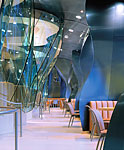|
|
||||||||
|
CONDÉ NAST
CAFETERIA New York 1996–2000 The Times Square headquarters of Condé Nast Publications contains what is surely the most lavish employee cafeteria. What could have been a relatively staid interior project if commissioned by a less adventuresome client instead provided Gehry with an unparalleled opportunity to push his experiments to new extremes. The architect's penchant for habitually reinventing materials—evident as early as 1964–65 in his appropriation of roadway supplies and techniques for the stucco exterior of the Danziger Studio and Residence in Los Angeles—is spectacularly demonstrated by the contoured architectural glass that winds through the cafeteria. The billowing glass, which encloses dining areas within the main room, is the key to Gehry's success in creating a sense of privacy while visually maintaining the space's openness and overall proportions. Each laminated glass panel is a unique curved form. The perimeter walls are clad in blue titanium whose shapes evolved from the formal vocabulary of the Guggenheim Museum Bilbao (1991–97). Designed to appeal to the culture of an organization whose publications include Vogue and Vanity Fair, much of the custom seating is in the form of curvilinear banquettes that recall the "power booths" the magazines' editors regularly occupy in Manhattan's finest restaurants, yet here they are available to all Condé Nast employees. A dazzling and witty commentary on the "see and be seen" culture, the cafeteria nonetheless provides a democratic environment with wide appeal and has quickly become the social heart of the organization. |
|||||||
